Quality NMEA 2000 cabling, the eBay way
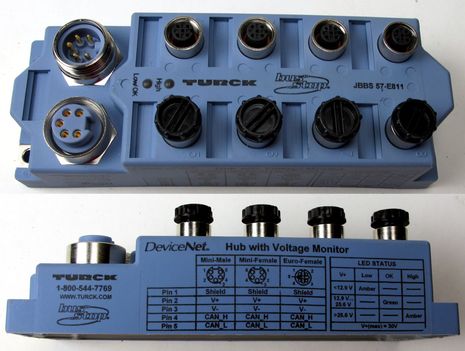 I’m not sure whether to thank or curse the Panbo reader who got me hunting for NMEA 2000 cabling equipment on eBay. There is a thrill to picking up a $290 Turck JBSS 57-811 DeviceNet multi-port junction box for about $35 to $45 with shipping (and there seem to plenty left here, here, and here). It’s beautifully made — fully potted with nickle-plated brass connectors and gold-plated brass contacts, plus a built-in voltage indicator — and it can definitely be a useful part of most any boat’s NMEA 2000 network, as I’ll demonstrate. But you may find yourself up late looking for related heavy duty N2K network components, probably getting confused by complex nomenclature and maybe even buying stuff you can’t use. Then again, you’re apt to learn how many ways there are to build a valid N2K network…
I’m not sure whether to thank or curse the Panbo reader who got me hunting for NMEA 2000 cabling equipment on eBay. There is a thrill to picking up a $290 Turck JBSS 57-811 DeviceNet multi-port junction box for about $35 to $45 with shipping (and there seem to plenty left here, here, and here). It’s beautifully made — fully potted with nickle-plated brass connectors and gold-plated brass contacts, plus a built-in voltage indicator — and it can definitely be a useful part of most any boat’s NMEA 2000 network, as I’ll demonstrate. But you may find yourself up late looking for related heavy duty N2K network components, probably getting confused by complex nomenclature and maybe even buying stuff you can’t use. Then again, you’re apt to learn how many ways there are to build a valid N2K network…
The cable and connector standard adopted for NMEA 2000 is a subset of the DeviceNet standard used in industrial automation, and if you try to equip your boat with used or surplus DeviceNet gear found online, the term “subset” will take on new meaning. It turns out that there are many forms of DeviceNet, and several of them are useless for N2K. But on a happier note, I’m pretty sure that the eBay purchases above constitute a small, high quality NMEA 2000 network at a bargain price. Recall that N2K includes two five-pin connector sizes, generally called Mini and Micro and perhaps best seen on this Maretron page. I’ve only seen the misnamed Mini connectors — they’re 7/8-inch in diameter — on large vessels, generally used for the trunk or backbone cabling with Micro drops to the various devices. Apparently, that’s also a common connector architecture for industrial automation, which explains the design of the Turck junction box and the preponderance of Mini size cabling when searching eBay for DeviceNet cable listings.
So the Turck JBBS 57-811 junction box is designed with male and female Mini ports for the network trunk and 8 Micro female ports for device drops. But in the photo above, I’m using one Mini to insert 12v power with terminating resistors screwed into the other Mini and one Micro port. In this case the JBBS is the entire backbone with 7 female Micro connectors ready to accept drops up to 6 meters long each. I’m also demonstrating how you can check for the proper 60 Ohm resistance across the white and blue data wires, because you may recall that NMEA 2000 is an impedance-driven networking technique. Heck, you could just use the Micro ports for all the connections, though it would be a bad idea to leave the Mini port contacts exposed (fine Turck male RKF-MC and female RSF-MC closure caps are available surplus, and there are probably many alternatives if you can find them).
By now you’ve probably realized that yours truly spent part of his winter collecting components for an N2K network that may be heavy duty enough to run a serious assembly line, but before discussing further, let’s look at a couple of mistakes. Doesn’t that look like a nice 0.8 meter Micro drop cable with a 90° female end handy for attaching to the back of many N2K devices? Well, look a little closer, because that male connector is not Micro size, but rather an even smaller DeviceNet standard size, variously called Nano or Pico. (Turck calls Micro size connectors Euro or EuroFast, by the way, and there are many such impediments to eBay search and identification.) At any rate, there are hundreds of these cables available on eBay for some reason, sometimes for as little as $5 each. At first, I thought they could be used with a raw wire junction box like Furuno’s or Actisense’s, but the cable is also UltraThin size with 26AWG wires, which is not up to N2K specs. Anybody want them?
I was also disappointed with this surplus DeviceNet power tap, though it’s built like a tank. I presumed that the two pairs of power leads meant that I could separately switch the two sides of the trunk line, as explained here on Panbo. But testing — and the further research I should have done in the first place — indicate that both power feeds go to both sides of the network, enabling redundant power sources instead of splitting the trunk. Note that Maretron obviously sources their Mini Powertap (PDF here) from the same source, except that theirs has two female backbone connectors, so that if you ever open the network live, the male pins shouldn’t be hot (unless the gender was changed somewhere). Meanwhile, Maretron’s Micro/Mid Powertap Tee (PDF here) is truly split (as is the Actisense QDP), which also helps with the issue of voltage drop in a large N2K network. Of course, voltage drop is also prevented by the 15 or 16 AWG power wires found in the Thick or Mid size cables that typically come with Mini size connectors, but note in the photo that a careless eBay shopper can find Mini cables that are the Light size (with 22 AWG power wires) normally found with Micro connectors…
It took a while, but eventually I learned to check attractive looking eBay offerings with manufacturer sites or PDF catalogs. It’s often easier to use parts numbers instead of product names, because the latter can get wicked confusing. “NMEA 2000” is never mentioned in this world, but sometimes you’ll see DeviceNet Micro/Euro/whatever cables that sure look like they’d be useful in our world. Like the Turck Daisy Chain cable above, which could very neatly provide a drop to, say, three N2K devices in a tight helm pod. It seems like the design takes care of the NMEA’s concern about daisychained displays where the network actually passes into and out of the device (though most major manufacturers offer it anyway). Unfortunately, I’ve never seen one of these cables outside of the Turck Connectivity Catalog, but the point is that DeviceNet is a sprawling and interesting cable standard.
So here’s another potential N2K network making use of the nifty Turck JBBS 57-811 junction boxes. I believe it’s valid to run the backbone through the junction box, but a better practice is to drop the junction boxes from the backbone. For Gizmo, I found some Mini size Tee connectors, including some with one female Micro drop connector, so most of the backbone is Micro size with Thick or Mid cabling, as are the drops to three JBBS junction boxes. It’s overkill, for sure, but there should be no voltage drop issues and plenty of room to grow. For now, it has one power feed fused 4 amps to account for all the Micro Thin cable drops, but I’ll keep hunting for a neat way to split the power into the Micro backbone. (I’m also switching the boat’s SimNet network to regular Micro, both because it will make device swapping easier and because Simrad is making the same switch. I didn’t have any problems with SimNet, though.)
If I’ve misunderstood something about quality NMEA 2000 cabling and the stuff that can be found used or surplus online, I dare say I’ll be corrected pretty quickly by readers and/or manufacturers. But I also modeled the network with Maretron’s ever better (and still free) N2KBuilder software. I was pleased to see that it recognized my hybrid Mini/Micro network as having a valid trunk and branch design with plenty of voltage. Note that I used two Maretron 4-drop Micro Multiport boxes (PDF here) to represent each JBBS 8-drop box (and note that this whole entry can also be argument for some to simply stick with NMEA 2000 certified cable and connectors made or sourced by quality marine electronics companies like Maretron). I purposely made one mistake to illustrate the point that even a fee Tees can serve like a multi-port box, but not when the total cable length from trunk to device exceeds 6 meters. Now, what mistakes have I missed?


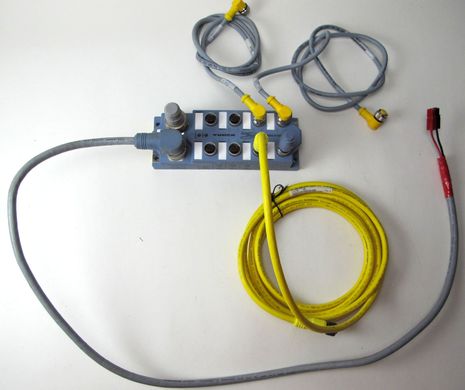
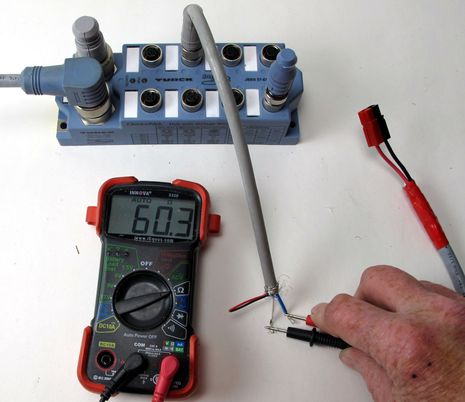
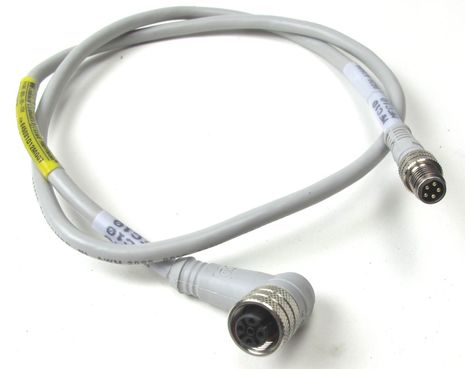


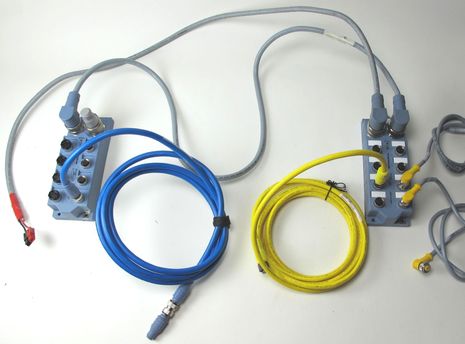
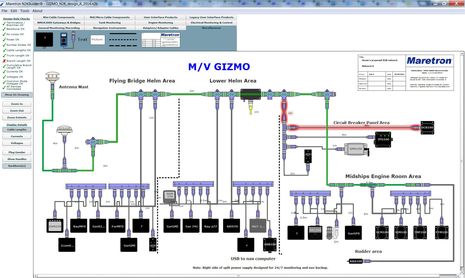


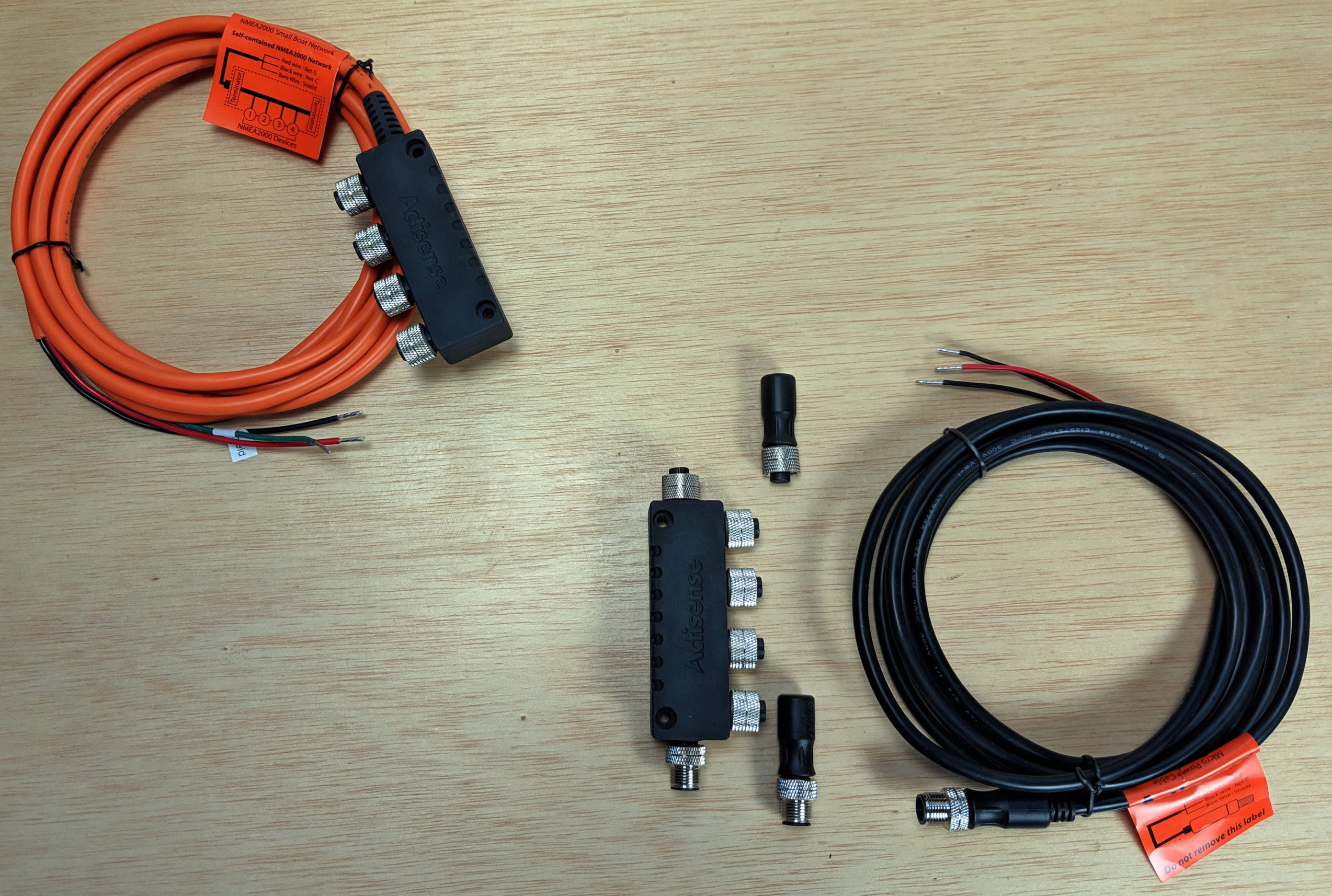








Wow, that was fast. The “surplus surplus” Thin cables have already been spoken for by reader John T here in Maine.
Which reminds that how poor I’ve been at promoting Panbo Classifieds. It’s true that there aren’t many listings for used gear there, but there really should be. The rate of sales for what has been listed is pretty impressive, plus the ads are free and the listing process is easier than eBay or Craigslist, I think. Please see if Panbo Classifieds can’t recoup some of your electronics dollars!
https://panbo.com/classifieds/
I won’t be so bold as to claim spotting a mistake, but I don’t see where your buss terminations are? Surely your wind instrument and rudder sensor aren’t terminations themselves, are they?
Is the short yellow “1m” wire the power feed?
I’m sure glad my system is a bit simpler than yours..:-b
Hartley, there are inline terminators at each end of the backbone. Maretron and Garmin sell them in Micro size, and there may be others. They’re kind of nice because you can add another drop to them (up to 6 meters). Incidentally, N2KBuilder would not have validated the backbone without terminators.
Yes, the powertap is yellow.
Great post, Ben! Remember when I advocated getting DeviceNet boxes like these on eBay…four years ago? 🙂
But in all seriousness, they worked great on the good-sized NMEA2000 network on our Nordhavn and were 100% reliable from day one.
Hm…probably should have clarified that I was referring to my forum comment here:
https://panbo.com/forum/2010/04/nmea-2000-install-problem.html
Great Article. Thx.
OK, Ben – I figured there had to be, but the diagram doesn’t make it easy to figure out where they are. The green line running through is confusing to me – it is partially on the Buss and partially on a spur, at least to my eye. I guess I should familiarize myself with the software..:-)
But it sure looks a lot neater than the hand-drawn diagram I have for my MUCH simpler RayMarine system. I may see if I can use it to diagram my stuff and consign my scribbled drawings to the history file.
Sorry, Hartley, but I’m glad you’re confused as it makes a point. The green line is what N2KBuilder sees as a valid backbone/trunk, and I agree. You’re seeing green on spur/drop/branch lines only because you’re used to the notion that backbones run straight thru Tees. CANbus/N2K doesn’t actually give a hoot about that. The backbone is simply the continuous network cable that has terminators on each end. It can carry data at least 100 meters over decent DeviceNet Thin cable and Micro connectors.
By the same token, N2K branches can be looser than normally depicted. They can go straight off a Tee, and/or include multiple Tees or a junction box. The only limit is that no device on a branch/drop/spur can be more than 6 meters from the backbone. That’s the only design error that N2KBuilder highlighted in red.
Thanks, Ben! I do understand the architecture of a CAN buss, but some of the graphic conventions of the diagram have me guessing. If I understand correctly, you’re telling me that the two buss terminations are located at the WSO100 wind instrument and in the connector inline with the cable to the RAA100 rudder sensor.
You are absolutely correct that my familiarity with the RayMarine hardware layout makes it tricky for me to understand – the devices to do what you’re doing there simply don’t exist in Ray hardware, though you could get fairly close.
I’m also thinking that the rather convoluted and overlapping sections in the lower center (surrounding the new devices you describe) are probably a pretty good representation of what is likely a serious nest of snakes..:-) Sounds like a good reason to label both ends of every cable.
Wow, that’s some network Ben! What’s your bus utilization with all of that running?
Have you tried using the snap feature in N2KBuilder? It might clean up your funky overlapping cables a bit.
Personally, I prefer to run the bus through those Turck boxes which have an in and an out since electrically it keeps the network looking more like a bus and less like a tree. I don’t think that violates the NMEA standard that says the network must not be routed through a device anymore than a tee would.
The only problem I see is the lack of a Maretron Alarm handler on the right hand (24/7) side of the network – your ALM100 and SMS100 will need to be told when to send alerts – Unless you are planning on doing this through the IPG100?
Thanks, Robert, but the powertap is that black box with short yellow cable at about top center. The SMS100 and one ALM are on the right side 24/7 leg, and should be able to work with the sensors on that side. Come to think of it, though, there probably has to be a DSM on that side to be the brains for alarms.
However, I have not yet figured out how to split the powertap cleanly and it may turn out that this whole network doesn’t use much 12v juice, especially when most of the screens are turned off. This is a work in progress 😉
Yeah thats what I meant about an alarm handler – a DSM to tell the ALM100 to make noise, and the SMS100 to send text messages, and then, perhaps more importantly to clear the alarm and stop the noise!
While I applaud any way to save a buck and still get the same results as buying the high priced spread, I am always a bit concerned about Ebay and low prices. My understanding is that Devicenet made industrial and not marine applications, if so care is needed in using these. Are these items NMEA certified? If not there is a potential for impedence mismatching and functionality issues with the network. Also what kind of warranty do they have. Maretron has a 2 year warranty as do other marine oriented manufacturers. Then there’s always the Chinese “knockoff”. Which we all know may or may not be the same quality as the original. These have a tendency to be sold on Ebay. So let the buyer beware.
@electronics diva,
NMEA2000 is a multipart standard that includes requirements for physical cabling as well as electrical and networking protocols. The physical cabling standard is the same as DeviceNet.
Warranty obviously varies by supplier and depending on whether you are buying new or used, but given that these are fixed devices with no moving parts, power supplies, or circuit boards, I think the failure risk when properly installed is very low.
In our case, as I mentioned above we installed eBay-supplied Allen-Bradley 4-, 6-, and 8-port hubs on our 30-device NMEA2000 network with flawless results. The network was tested over 3 years and 11,000+ miles of power cruising.
Ben, I went to the link you included, and requested the info for downloading the N2KBuilder program – but I never heard back from Maretron. Do you have to be on their customer list to get access?
Hartley, you should have gotten the download email in a minute or so of requesting it. Request again and check your spam filter.
TBH, I’m not sure why they bother with this step at all. I’ve probably downloaded N2Kbuilder a dozen times and I’ve never gotten so much as a new product announcement email from them.
Hi Tim, well, I just tried it again, using two different email addresses – and nothing (including the spam catcher here and the one at my email servers). I guess something really doesn’t like that email!
Kudos and a big THANK YOU to Mark Oslund of Maretron, who send me a personal email with the instructions on downloading N2KBuilder!! I have no idea where the official emails were being scraped off, but I have everything now, and I’m looking forward to trying it out.
Looking at your design for the N2KBuilder you are using Maretron 4-drop Micro Multiport boxes. These have a male jack on them so you can use a standard N2K cable that is M/F. Using the Turck JBSS 57-811 it has all female ports.
Are you making all your own M/M cables?
@FatDash:
I don’t know what Ben used but in cases like that the Maretron field-attachable connectors (FACs) can be used to sort out the cable gender issues. Or, if you don’t want to go through the hassle of using a FAC (NMEA2000 micro wires are tiny) or are concerned about reliability, Actisense has 10″ gender changing cables, which run about $20:
http://www.actisense.com/products/nmea-2000-network/gc-gender-changer-cable-assemblies.html
/afb
Hello FatDash,
Adam is quite correct but there are other ways to use the Turck JBSS multiport. My install looks something like the last photo. The backbone is Mini not Micro cable with a Mini power tap tee’d in. One JBSS is simply inline with the backbone using its Mini male and female ports. The other JBSS is dropped from the backbone using a Mini cable. Thus all 8 female Micro ports on each JBSS is available for device drop cables. I explained in the last paragraph that I couldn’t quite model this in N2KBuilder, but got as close as possible.
I believe it’s also possible to use just the Mini female ports on a JBSS without resorting to field-attachable connectors or a gender changing cable. Use one port for the power tap and make two others backbone connections, (or just screw male terminators into them if a 5 device network is all you need).
Note that the standard Maretron Micro powertap tee also has female connectors for both backbone connections. It can be a hassle if you have to move the power tap but the idea is that even if you break open the network when it’s hot you’ll never expose hot male 12v pins. Similarly it would be a bad idea to leave the Mini ports on the JBSS uncapped if you don’t use them. I linked to available caps in the entry, but think it can also be done reasonably well with rescue tape.
The Maretron Micro powertap tees also are a BIG hassle if you want to use more than one in order to independently power devices on the bus.
Hi, do you know where can I find simnet pinage description?
I have bought some Simrad used equipment (IS20 Graph, Wind and Mult), Autopilot TP22 and Radio RS25.
But now I am suffering a lack of information about connectivity
best,
rodrigo
Rodrigo, Simnet wire colors are almost a match for other NMEA 2000 type cables, so the pin out should be easy to figure out:
https://panbo.com/archives/2008/02/n2k_cable_mixing_not_a_big_woop.html
BUT I think it’s a bad idea to cut and splice any N2K cabling if not forced to, and SimNet especially because of its light construction and the fact that the drain “wire” is foil.
I suggest that you learn how to build a SimNet network and find the bits you need for your system. Some of the links in this entry don’t work any more…
https://panbo.com/archives/2010/07/simnet_network_testing_more_nse_goodies.html
…but I found it easy to Google up a SimNet manual:
http://www.chicagomarineelectronics.com/Simrad%20Documents/SimNet/Simnet-Install-Man.pdf
Better yet, buy the SimNet to male DeviceNet adaptor cables needed to put your gear on a standard N2K cabling system:
http://www.pbsboatstore.com/Simrad-24005729.htm
It’s important to learn how any N2K network goes together with powertap, backbone, terminators, and drop lines.
And there are possibly tolerable exceptions. Note that daisy chaining multiple devices on a single N2K drop — the reason your IS20 displays each have two ports — is not allowed by NMEA but several manufacturers support it and it’s working on many boats.
Will this work to replace a long string of N2K Tees? JTBS-57VM-M633 http://www.rivercityindustrial.com/turck-jtbs-57vm-m633-bus-stop-devicenet-jtbs57vmm633-network-station
Learn from my mistakes, Howard; always check the product catalogs, datasheets, etc.!
I think those are (big) Mini size connectors, not Micro size. Datasheet with dimensions and more here:
http://www.alliedelec.com/turck-jtbs-57vm-m633/70000332/?source=Datasheets360
Do you have the part numbers used for the terminators for the micro and mini connectors?
You can now find several different mini connectors on Aliexpress for $2-5 under “M12 5-pin”. Check the photos first; most are listed as “aviation plugs”, as the sellers don’t know the difference between Devicenet & GX-12 connectors.
Ben, can you recommend a specific source for the appropriate Turck M12 DeviceNet 5-pin MALE right-angle cables to fit the JBSS? Looks like you found a couple from your photos. I have been looking and looking on eBay and other places but so far no joy. Lots of FEMALE right angle, straight and 3/4-pin cables, but haven’t found a single correct one for this box. Thanks.
Sorry, no. eBay is obviously spotty, but trying to find these cables without the NMEA 2000 nomenclature is quite hard because DeviceNet actually includes multiple connector types and some companies use completely different names anyway.
That said, I have some short black N2K cables with metal 90 degree connectors at both ends that are made by LTW. Also, both Maretron and Actisense offer high quality 90 degree male field attachable connectors.
And Molex seems to have every possible configuration of M12 connectors if you can figure them out and then find a source. Would this work for you, for instance:
https://www.molex.com/molex/products/datasheet.jsp?part=active/1200698666_CORDSETS.xml
Ben, thanks for the options. I think I’ll keep looking for the molded-on connectors and cables as there are many possible sources of surplus Turck components out here in the Bay area (and the field-attachables are $20+ each!)